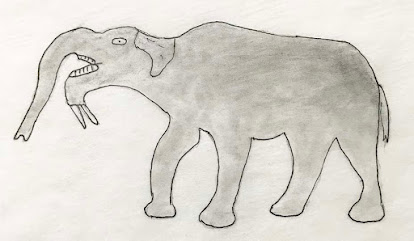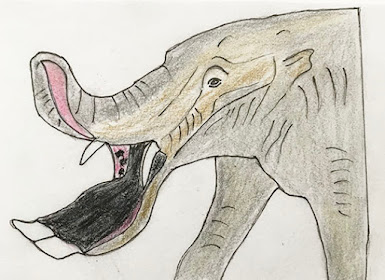A COMPILATION BY R. SQUIRES OF CENOZOIC LAND BRIDGES MENTIONED IN THE GEOLOGIC LITERATURE AND REFERRED TO IN MY UPCOMING BLOG POSTS: This post provides vital background information that concerns a series of subsequent posts by me on various Cenozoic land-mammals (for example, hippos, sloths, camels, mastodons, etc.). One of the major themes that concerns all these animals is how and when they migrated from one continent to another. As you will see, some migrated from continent to continent via land bridges (listed below). Other groups, however, were/are confined to a single continent.
De Geer Land Bridge
Connected various parts of the high Arctic in the early Cenozoic: Canadian mainland, Ellesmere Island, Greenland, and Svalbard to Norway. De Geer existed (intermittently?) at or near the end of the Cretaceous until the early Oligocene. See Brikiatis (2014).
Thulean Land Bridge
Extended from North America to Greenland, (intermittently?) from early Cenozoic until the early Oligocene. See Brikiatis (2014).
North Atlantic Land Bridge (NAtLB) or Greenland-Scotland Land Bridge
Extended from Greenland to Scotland during the middle Cenozoic.
Turgai Land Bridge
Extended between east and west Eurasia (intermittently in the Eocene?) during the Oligocene. See Brikiatis (2014).
Berginia 1 Land Bridge
Extended from North America (Alaska) and Siberia. It occurred intermittently during Eocene and Oligocene time (between 55 and 25 million years ago (mya).
The following sequence of maps versus various intervals of geologic time (Eocene, Miocene, etc.) provides summation of the major land bridges mentioned in my list:
Note: The general term “Beringia” has been used extensively in the published literature. The term is used mainly, however, for only for the most recent connection between North America and Sibera, but there have been at least two other similar land connections; hence the overall term “Berginia” is misleading. That is why I labelled the first two "Berginias" as 1 and 2, and why I chose to label the youngest Berginia (the Ice Age one) as number 3.
Note: North America/Siberia land connection: It is possible that this connection occurred also during the latest Cretaceous (65.6 mya), thus explaining some dinosaur distributions.
Beringia 2 occurred intermittently during the Miocene (between 25 and 5 million years ago, especially during late Miocene time. During that time interval, various groups of land mammals (many now extinct), as well as land plants, migrated primarily between North America and Eurasia.
Greater Antilles-Aves Island (GAARlandia)
Latest Eocene/earliest Oligocene time only; shortly thereafter this island chain was dismantled and submerged. Today, only islands exist.
This very temporary land bridge allowed for some South American land mammals (ground sloths, capybaras) to migrate into Central America. Some current workers are hesitant to embrace this seemingly plausible migration route as not being all that viable.
Great American Biotic Interchange (GABI)
This acryonym refers to the greatest land animal exchange in Earth’s history = “Greatest American Biotic Interchange.” This exchange, which took place at the Isthmus of Panama portal, started at the Pliocene-Pleistocene boundary about 3 mya and is still going on. As shown in the following diagram, most of the animal migrations were southward out of North America into Central and South America (e.g., horses, mastodons, camels/llamas, tapirs, etc.); some animals migrated northward (capybaras, armadillos).
The "cats" arriving from North America were cougars, jaguars, and also saber-tooth cats. Other animal groups that migrated both ways were various insects, amphibians, snakes, alligators, turtles, tortoises?, and some flying birds.
The large South American carnivorous land birds (phororhacoid ground birds----see one of my previous posts) reached also Texas and Florida during GABI.
Beringia 3
The latest high-latitude North Pacific connection between Alaska (North America) and Siberia (Asia) during the four Pleistocene Ice Ages (the most recent advance of ice was about 10,000 years ago). Glaciation caused the “Bering Strait” to be closed from time to time.
Note: The acronyonym “NALB” (North America Land Bridge), which has been used also for the Beringia 3-Pleistocene Ice Age connection, should be avoided because it can be confused with the North Atlantic Land Bridge (a.k.a. as the middle Cenozoic Greenland-Scotland land bridge during the Cenozoic).
OVERVIEW OF MAMMAL GROUPS THAT USED LAND BRIDGES FOR MIGRATION. All of the groups listed below (except humans) will be discussed in my upcoming posts.
Beringia 3 (Pleistocene time)
Mammoths
Humans
GABI (Pliocene-Pleistocene boundary)
Capybaras
Ground sloths
Glyptodonts
Cuvieronius gomphotheres
Beringia 2 (Miocene time)
Camels
Tapirs
Horses
Gomphotherium
Ambelodontidae (shovel-tusked gomphotheres)
Mastodons
Beringia 1 (Eocene time)
Unitatherium
Brontotheres
Horses

























